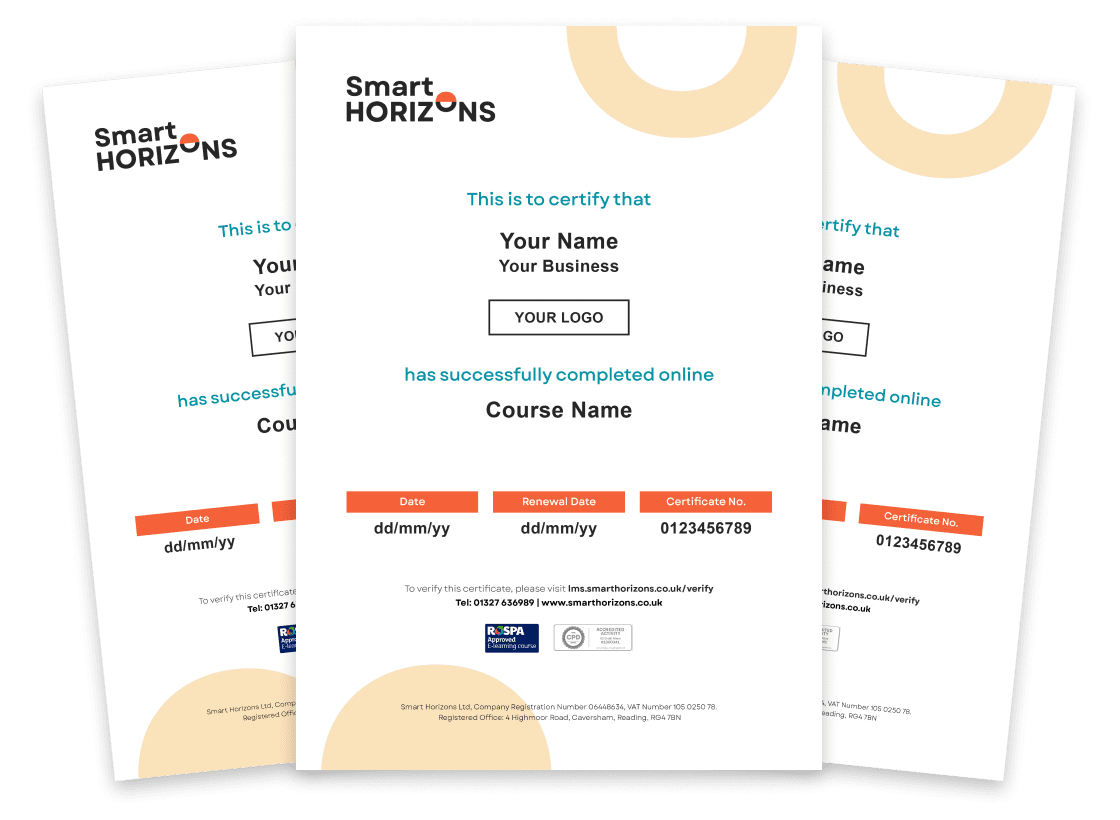What you will learn
This online Safeguarding Lead Training for Children and Vulnerable Adults will help you understand your key responsibilities of being a safeguarding lead and ensure that good safeguarding practices are employed across your organisation.
By the end of the course you will be able to:
- Refresh your existing safeguarding knowledge for children and adults at risk, including identifying signs and types of abuse.
- Familiarise yourself with the relevant safeguarding legislation and assessment frameworks.
- Understand the role and responsibilities of a Designated Safeguarding Lead.
- Handle and process concerns correctly.
- Accurately record and share safeguarding information.
- Ensure good safeguarding practice is embedded within your organisation and promote a culture of open communication.
- Collaborate with both statutory and non-statutory agencies to protect children and vulnerable adults.
- Provide advice, information and training to other staff members.
- Maintain effective communication channels promoting safeguarding and understand the importance of safe information sharing.
Modules
Your Title Goes Here
1. Introduction
In this module, you will get an overview of the duties and requirements for the Designated Safeguarding Lead role to safeguard children and vulnerable adults.
Upon completion of this module, you will have a comprehensive understanding of the qualities, duties and skills required to be a successful Designated Safeguarding Lead in your organisation.
2. Building on Existing Safeguarding Knowledge
This module deepens your understanding of safeguarding by revisiting and expanding upon fundamental safeguarding and protection concepts.
By the end of the module, you’ll have a renewed grasp of various abuse types, their symptoms in individuals, the significance of remaining impartial concerning abuse and the importance of staying child and person-focused.
3. Safeguarding Law and Guidance
In this module, you’ll explore safeguarding legislation, gain insights into individual needs and familiarise yourself with regional legislation variations across the UK.
Upon completion of the module, you’ll understand the connection between these laws and safeguarding practices and clearly understand your responsibilities within the safeguarding process.
4. The Designated Safeguarding Lead Role
The role of the Designated Safeguarding Lead is pivotal in ensuring children and vulnerable adult’s safety and fostering a protective culture within an organisation. This module clarifies the importance and responsibilities of this position.
Upon completing the module, you’ll understand how to serve as the primary safeguarding contact in your organisation, create effective safeguarding policies and identify where to get advice and guidance when necessary.
5. Communication: Recording and Sharing Information
The DSL role emphasises fostering effective communication. It’s vital to establish a culture where open dialogue is encouraged, obstacles to transparent communication are removed and inter-departmental conversations are promoted.
Upon completing this module, you’ll recognise the importance of effective communication, learn to disseminate information securely and understand the DSL’s role in championing a culture of open conversation.
6. Collaborating with Safeguarding Agencies
The DSL is a central contact for many different agencies. Understanding the role of these agencies and the tools they use will help you in your DSL role to respond quickly and effectively to different safeguarding concerns.
By the end of this module, you’ll understand about the Local Safeguarding Children Board (LSCB) and other statutory and non-statutory agencies and how all these official agencies should work effectively together to keep children and adults safe and promote their well-being.
7. Managing Complaints and Allegations
A transparent culture is crucial for addressing safeguarding issues. The DSL must ensure every complaint is taken seriously and that the complaints procedure is just and appropriate.
After completing this module, you’ll grasp the details of the complaints procedure, recognise who should be involved and understand the correct actions for addressing and reporting concerns.
Who is this course for?
- Education staff in adult learning
- Healthcare and non-clinical staff
- Social care workers
- Carers
- Administration staff who may come into contact with children and vulnerable adults
- Volunteers, church leaders and charity workers who deal with children and vulnerable adults
Our online Safeguarding Lead Training for Children and Vulnerable Adults is tailored for managers, practitioners and those in a DSL position. It’s also ideal for those looking to enhance their safeguarding expertise or are thinking of becoming a DSL.
Certification
This online Safeguarding Lead Training for Children and Vulnerable Adults course is accredited by The CPD Group.
Upon successful completion of this online course, you’ll be sent a personalised digital certificate as a PDF, enabling you to download and print it.
You can access a copy, reprint or download this certificate on our LMS (Learning Management System). This is your proof that you have been trained in safeguarding best practices and achieved compliance. The certificates include a verification number so anybody can authenticate the certificate’s legitimacy.
Our certifications include a renewal date but there is no legal requirement to renew your training and certificate within a specific timeframe. However, we do recommend that you arrange refresher training after 2 years as safeguarding guidance does change. You should update your safeguarding knowledge and skills regularly.


Genuine reviews
Frequently Asked Questions
Your Title Goes Here
Does this online Safeguarding Lead Training for Children and Vulnerable Adults qualify me to become the Designated Safeguarding Lead in my organisation?
If you are a Designated Safeguarding Lead (DSL) for your organisation, you must complete both an introductory safeguarding training course and a specific safeguarding lead training course. This online Safeguarding Lead Training for Children and Vulnerable Adults builds on existing knowledge gained from our online Safeguarding Children and Vulnerable Adults training course.
We recommend that Designated Safeguarding Leads working in education check with their appropriate safeguarding agencies to understand the DSL training requirements for their local authority. For healthcare professionals, it is essential to refer to the safeguarding training framework used by the healthcare sector to ensure you’re selecting the appropriate safeguarding course.
Before taking this Safeguarding Lead Training, should I complete an introductory safeguarding course?
Yes. Before taking this safeguarding lead training, you should complete an introductory course such as our online Safeguarding Children and Vulnerable Adults course. This Safeguarding Lead Training for Children and Vulnerable Adults expands on foundational knowledge, delving deeper into processes, procedures, legislation, agency collaboration and managing allegations and making referrals.
What is the difference between the terms ‘vulnerable adults’ and ‘adults at risk’?
The terms ‘vulnerable adults’ and ‘adults at risk’ essentially convey the same meaning. However, ‘vulnerable adults’ is now less frequently used, with ‘adults at risk’ becoming the preferred term. For an detailed exploration of these phrases, refer to our article titled ‘Safeguarding Adults at Risk: A Guide‘.








